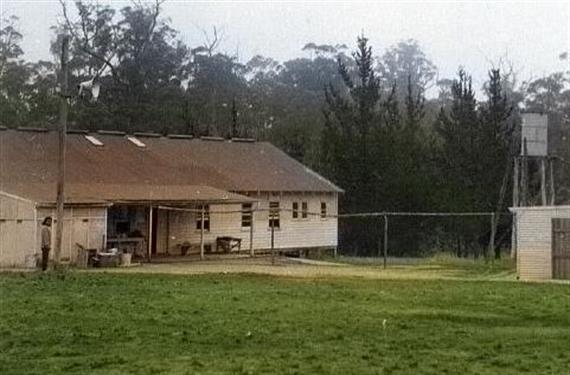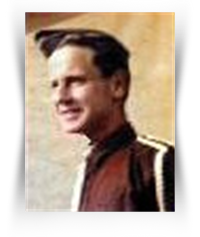My reputation as a dunny builder is unsurpassed in the annals of Betar Camps in Victoria. Alas, I was never allowed to show my expertise at any camp held in New South Wales - which was probably due to Melbourne - Sydney rivalry rather than the fact that I never went to a prep camp there. The planning of the NSW prep camp dates seemed to be purposely timed to coincide with my supps (supplementary exams) which I always seemed to have, or my end-of-year job which I needed to fund my camp fees. Quite a coincidence, eh?
Dunny building is not just an acquired skill. A great amount of training is required, including a period of apprenticeship with the greatest. I got my start at Kinglake West II (1954-55) at my first prep camp. Unfortunately, Kinglake West had septic tanks and so the training was confined to digging a grease pit. For those of us who roughed it at this or any camp, you know that a grease pit is where you bury all of the kitchen waste since, of course, there was no garbage removal.
Harry Stuart's
Recollections
Harry M. Stuart (the 'M' stands for Middlename - or Melvyn) was a member of Betar from 1952 through the mid-sixties when age disqualified him from being a member of a 'youth' movement. His reputation was built solidly as the Dunny-Digger Supreme and his many wonderfully-relieving creations can be seen in his album.
Picture this - Kinglake West camp II 1955-56, very early in the morning. It’s even before the K’tzin Toran (daily duty officer) and his/her henchmen woke up the camp to do that PT stuff we all loathed.
All of us pulled kitchen duty from time to time. Whether being on KD it was fortunate or unfortunate is actually debatable. On the plus side, you got out of those boring lectures, dumb games, knot tying and Tass! On the minus side, you had to peel potatoes, scrub the pots, chop wood for the fire and clean the dining room. On the plus side, you got to help cook and taste the next meal - which usually proved to be on the minus side most of the time.
At Kinglake West, most of us were housed in huts. We had real latrines, not the 6 foot hole with a seat and a hessian surround. There was also a dining hut, complete with a kitchen, running water (when the pump worked) and a wood-burning stove. Wood for the fire had to be gathered and, of course, chopped. Fires had to be lit - and when you were on kitchen duty (KD), you missed those lectures on practical fire lighting. You know, the stuff about putting in little bits first, then larger bits and, finally, the big bits.
1955-56: 1 - Hair Today, Gone Tomorrow
Fire had to be started with plenty of newspaper. When you are at camp, you only had old camp newssheets, Haderechs, spoiled Gestetner stencils and letters to be sent home to parents that were too much bother to post. So, obviously some other form of catalyst had to be used since real flammable supplies were rather short. Yes, you’re right - that catalyst was kerosene. That was our staple fire starter. Everyone used it, some more carefully than others.
One January 7th (sue me if I’m wrong), an individual whose family name started with R was assigned KD and had to light the fire. It was early morning - water had to be boiled for the porridge, and for the coffee with chicory essence, flavored with Nestles condensed milk. Newspapers were scarce; no-one had made any mistakes creating the previous day’s camp newspaper so there were no old stencils to help start the fire.
R threw in all the wood he could find - unfortunately there no little bits - just big bits. OK, there was still the kero. The protocol was to place a liberal amount on the big bits, hold a match against them, and she’ll start.
Now, that doesn’t always happen immediately since kerosene is not that flammable. Once lit, kero helped the fire take better hold and even got green wood burning, for a while at least. So, if a little kero is good, a lot of kero would be better, no? When the fire did not start immediately, R threw some more kero on to it and waited. And waited. Nothing, just some fumes. ‘Now, where was that fire?’ R thought and decided to take a look. With that, R opened the stove door and peered in. It was very dark in the stove - maybe the fire was in a corner. So he placed his head almost into the round opening.
Whoomp! The air that rushed in caused a sudden ignition and a sheet of flame exuded from the open stove, very nicely adding a tan to R’s face and removing all hair superfluous to the season. If R shaved, he wouldn’t have to for a week.
While all this seems funny now, it was then too. No injury, just a singed ego and that horrible odor of burning hair.
(Sorry, Brian, just had to tell that story).
The dining hall on the left with quick access to the latrines (on the right). - Photo: Brian Rudzki. (No connection to the subject of this Recollection - much.)
By Harry M. Stuart, MDB
The grease pit at Kinglake West II:
(L to R) Harry Stuart (apprentice), Sam Offman; Henryk Kranz. Not pictured (getting coffee) Anne Entenberg
Sure, scoff at that. Big deal, you may say! But how many of you knew that you were supposed to dig that pit DOWNWIND away from the dining hall and NOT upwind and next to it? Two rather important design considerations. And that’s where that training paid off! After that camp, I never placed the any of the dunnies next to the dining hall.
At the next camp - Kinglake West III (1955-56), I qualified for the BDB (Bachelors of Dunny Building). Although we were again relegated to grease pit excavation another essential element of this craft was learned - geographic location. I learned that you don’t dig the grease pit (or a dunny) in the same place as last year, no matter how convenient it may seem. Now this was earth shattering because we are all creatures of habit and lean toward the path of least resistance. I mean, why find another site when the last one was just so perfectly placed? I guess it’s a capacity thing or has something to do with whistling against the wind.
Finally, in 1956-57 at Wonga Park I, I was cut loose to dig my own dunnies - two of them, of course. There were no pictures to record this historic event and the only evidence of success seemed to be that (i) no one was reported to have fallen in due to collapse and (ii) no one said that they wouldn’t use the facilities for any reason. Of course, the alternative would have been much worse - you just can’t wait 11 days until you get home.
A holey day at Wonga Park I
Woori Yallock VI (1957-58) was very well covered by the press, both during construction and during the grand opening. The DCI (Dunny Construction Inspector) Harold Helmer made sure that there were no leaks, as the photo testifies. This inspection was carried out before first use, although Harold hinted that it really didn’t matter. Strange fellow.
Harold Helmer, dunny QA dept.
Leah Feder officially cut the ribbon and we all settled down to initiate the facilities, one at a time, of course.
Leah Feder, cutting the cord at the official opening
At Wonga Park II (1958-59), we had a dilemma. There was a single septic facility which was left over from the time of the Boy Scout Jamboree one or two years before. However, the wooden surround had been tipped over and we decided (rather foolishly) to use it for firewood in the kitchen instead. That saved us from gathering firewood for a few days but we were permanently excluded from the site in future years
Eric Aufgang, in a typical pose, deciding whether this facility would be used without a surround
Therefore, back to the big dig and two more wonderfully designed facilities were constructed. That got me my MDB and, as it turned out, was my last and finest hour. Subsequent camps no longer required my expertise or could not get it due to my non-attendance at prep camps.
How I got my MDB (Masters of Dunny Building)
© 2002 Harry M. Stuart
Contents
Note: This photo graced the notice board of the Melbourne High School Staff Room for a few weeks - with the caption: is this you?

